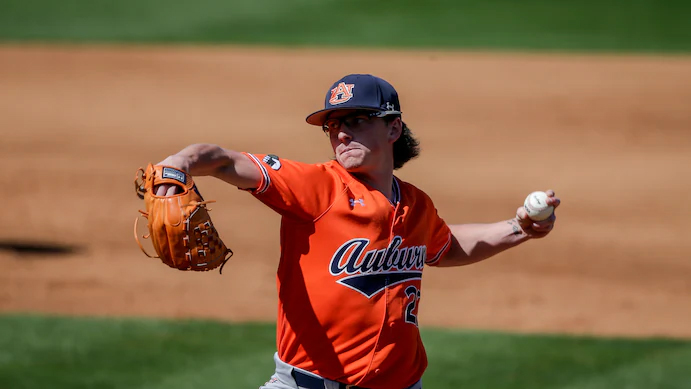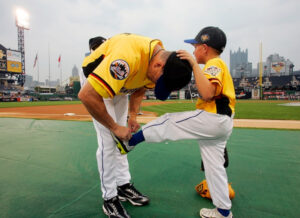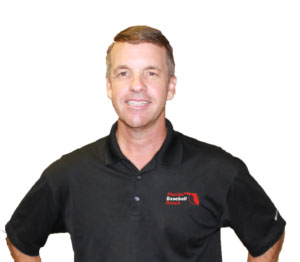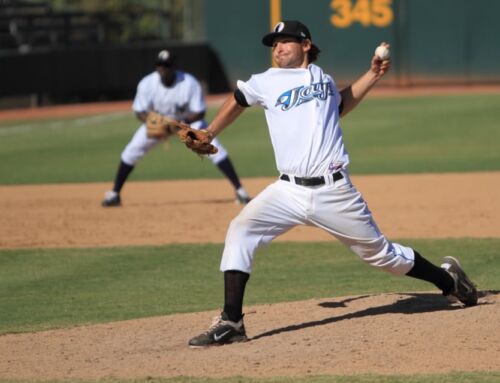
Original Article Washington Post – 9/9/21: https://www.washingtonpost.com/sports/2021/09/09/peyton-glavine-nationals-prospect/
Peyton Glavine, son of Tom, has his father’s change-up and his own climb ahead
Earlier this summer, Randy Sullivan and Marcus Hatley watched a Major League Baseball hopeful throw inside the Florida Baseball ARMory, Sullivan’s training facility and performance science lab. Looking at the data, collected with a TrackMan device and a mound measuring the ground reaction to the pitcher’s delivery, Hatley, the facility’s director of pitching, made a note to Sullivan, its founder, about the young left-hander’s change-up. A small tweak, they thought, could go a long way.
Then a bit of doubt crept in.
“Wait, wait, wait,” Sullivan recalled thinking. “We’re about to tell Tom Glavine’s son how to throw a change-up?”
But Peyton Glavine showed up there to gain velocity and learn. The work was crunched into just under a month. And when Sullivan shared the numbers with the Washington Nationals, showing Glavine’s baseline velocity raised from 86 mph to almost 90, General Manager Mike Rizzo’s front office signed him as an undrafted free agent.
Darren Baker has long been known as Dusty’s son. Now he’s paving his own way.
The name, of course, carries a Hall of Fame pedigree. Yet a name won’t help Glavine rise through the Nationals’ system. He can only help himself. Through 6⅓ innings as a reliever in the Florida Complex League, Glavine, 22, has yielded one earned run and two hits while striking out nine.
“You know, honest to God, it’s pretty cool to me that me and him are pretty similar pitchers,” Glavine said. “Because you always grow up and your dad’s your role model. You want to be like your dad. So for me to be where I am now, and be such a similar pitcher in terms of what we throw, how we throw … that doesn’t really get to me at all, the expectations and stuff, because he was so good about helping me realize that it’s not about that.
“It’s about your love for the game, and it’s about what you want to do in this game.”
But Peyton Glavine was and remains a long shot to join this group. He committed to pitching as a high school junior. At Auburn, where he made just two starts in three years, he posted a 5.14 ERA in 15 appearances as a junior. His change-up was sharp, using the same grip and strategy his dad once leaned on: trying to throw it straight at the catcher’s foot. Glavine needed a harder fastball, though, or at least a higher floor with his velocity. So he went to see Sullivan in Lakeland, Fla.
“We all know that you can get outs without a good fastball. It doesn’t have to be elite,” said Sullivan, whose son, catcher Jake Sullivan from the University of South Florida, also signed with Washington as an undrafted free agent. “But we also know that it makes it a lot easier if you have a good one, and people at the next level, that’s what they’re looking for. You enter a beauty contest and the judges like your fastball, so you got to have it.”
The Nationals have a direct connection to Sullivan’s facility. Jordan Rassmann, an analyst in Washington’s research and development department, spent almost three years there, rising from data analytics intern to director of research and development. His next job was joining the Nationals in January 2020. The familiarity helped the front office sift through Sullivan’s reports on Glavine, who spent June fine-tuning his delivery.
By the time he left Sullivan, Glavine was generating more power with his lower half, even topping out at 92 mph. Part of that was using his glutes to drive down the mound, transferring energy through his torso to his arm. With spin and release point data, they made sure his fastball and curveball were mirror images — starting with the delivery — before moving in different directions. They keyed on a three-pitch mix of fastball, curve and Glavine’s passed-down change.
“Velo really just allows people to get away with some more mistakes, and that’s kind of what I learned from being a bit of a lower-velocity guy,” Glavine said. “It’s not that you can’t get people out. It’s more that you just have to be maybe one step ahead of the hitter, or your location has to be pretty spot-on. Honestly, I’m glad that that’s kind of the way that I was because it teaches you how to be a pitcher. And obviously growing up with my dad, he was basically my pitching coach and that’s how he was.”
So Peyton doesn’t shy away from being Tom’s kid. He is too young to remember the Atlanta years, when Tom played a season with Nationals Manager Dave Martinez. He does remember the Mets, running around the Shea Stadium clubhouse and hanging for batting practice. And when he arrived in West Palm Beach, Fla., in August, beginning an upward climb with the Nationals, father and son realized something during a phone call.
Peyton was in the same hotel Tom stayed in for his first major league spring training. They shared a good laugh.

Randy Sullivan, MPT, CSCS CEO, Florida Baseball ARMory



